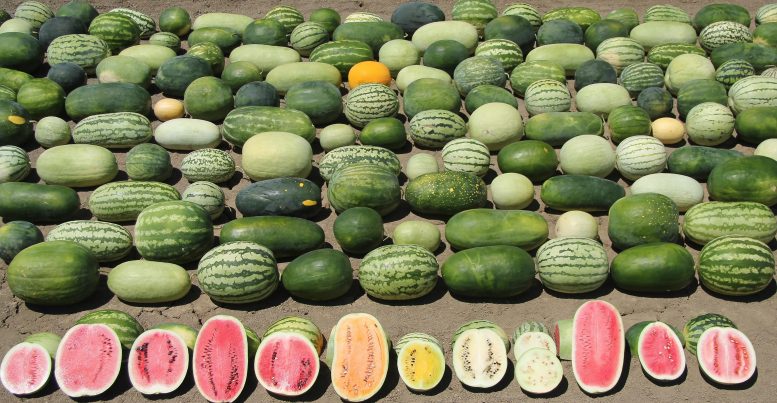
The seven species of watermelon have an incredible amount of diversity. Credit: Xingping Zhang/Syngenta
An international team of researchers has taken a comprehensive look at the genomes of all seven species of watermelon, creating a resource that could help plant breeders increase the domestic fruit’s quality and ability to thrive during an era of climate change.
When many people think of watermelon, they likely think of Citrullus lanatus, the cultivated watermelon with sweet, juicy red fruit enjoyed around the world as a dessert. Indeed, watermelon is one of the world’s most popular fruits, second only to tomato – which many consider a vegetable. But there are six other wild species of watermelon, all of which have pale, hard, and bitter fruits.
Researchers have now taken a comprehensive look at the genomes of all seven species, creating a resource that could help plant breeders find wild watermelon genes that provide resistance to pests, diseases, drought, and other hardships, and further improve fruit quality. Introducing these genes into cultivated watermelons could yield high-quality sweet watermelons that are able to grow in more diverse climates, which will be especially important as climate change increasingly challenges farmers.
“As humans domesticated watermelon over the past 4,000 years, they selected fruit that were red, sweet, and less bitter,” said Zhangjun Fei, a faculty member at Boyce Thompson Institute and co-leader of the international effort.
As described in a paper published in Nature Genetics on November 1, the researchers made these insights using a two-step process. First, they created an improved version of a “reference genome,” which is used by plant scientists and breeders to find new and interesting versions of genes from their specimens.
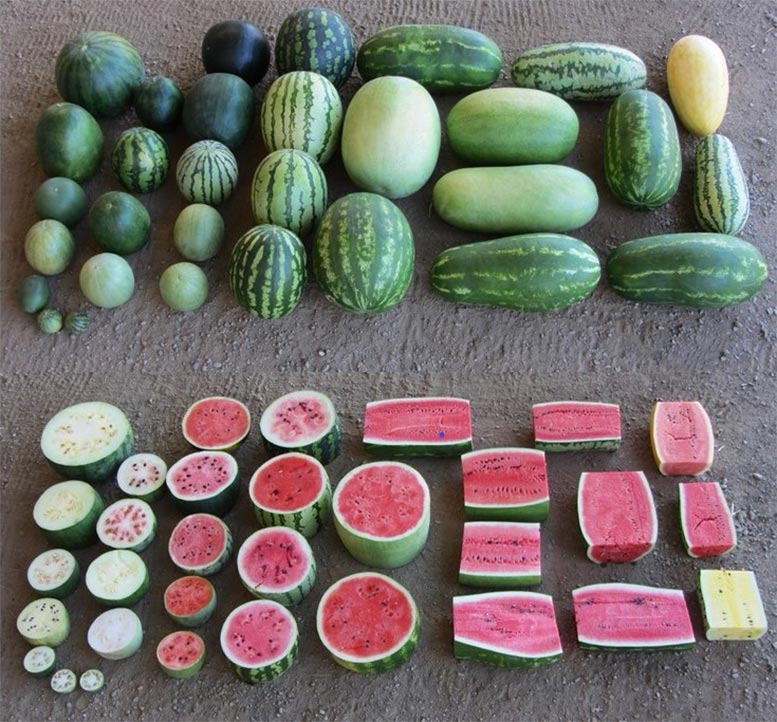
Cultivated watermelon’s wild relatives are very genetically diverse, making them likely sources of genes that confer tolerance to pests, diseases, and abiotic stresses like drought and high salinity. Credit: Xingping Zhang/Syngenta
“Unfortunately, as people made watermelons sweeter and redder, the fruit lost some abilities to resist diseases and other types of stresses,” said Fei, who is also an Adjunct Professor in Cornell University’s School of Integrative Plant Science.
Fei co-led the creation of the first watermelon reference genome using an East Asian cultivated variety called ‘97103,’ which was published in 2013.
“That first reference genome was made using older short-read sequencing technologies,” Fei said. “Using current long-read sequencing technologies, we were able to create a much higher quality genome that will be a much better reference for the watermelon community.”
The group then sequenced the genomes of 414 different watermelons representing all seven species. By comparing these genomes both to the new reference genome and to each other, the researchers were able to determine the evolutionary relationship of the different watermelon species.
“One major discovery from our analysis is that one wild species that is widely used in current breeding programs, C. amarus, is a sister species and not an ancestor as was widely believed,” Fei said.
Indeed, the researchers found that cultivated watermelon was domesticated by breeding out the bitterness and increasing sweetness, fruit size, and flesh color. Modern varieties have been further improved in the past few hundred years by increasing sweetness, flavor, and crispy texture. The researchers also uncovered regions of the watermelon genome that could be mined to continue improving fruit quality, such as by making them bigger, sweeter, and crispier.
In the past 20 to 30 years, plant breeders have crossed cultivated watermelon with the sister species C. amarus and two other wild relatives, C. mucusospermus and C. colocynthis, to make the dessert watermelon more resistant to nematode pests, drought, and diseases like Fusarium wilt and powdery mildew.
These types of improvements using wild relatives are what excites Amnon Levi, a research geneticist and watermelon breeder at the U.S. Department of Agriculture, Agricultural Research Service, U.S. Vegetable Laboratory in Charleston, South Carolina. Levi is a co-author of the paper and provided the genetic material for many of the watermelons used in the study.
“The sweet watermelon has a very narrow genetic base,” says Levi. “But there is wide genetic diversity among the wild species, which gives them great potential to contain genes that provide them tolerance to pests and environmental stresses.”
Levi plans to work with BTI to discover some of these wild genes that could be used to improve the dessert watermelon, especially for disease resistance.
“Watermelon is susceptible to many tropical diseases and pests, whose ranges are expected to continue to expand along with climate change,” says Levi. “We want to see if we can bring back some of these wild disease-resistance genes that were lost during domestication.”
Other co-authors included researchers from the Beijing Academy of Agriculture and Forestry Sciences and the Chinese Academy of Agricultural Sciences.
The study was supported in part by funds from the USDA National Institute of Food and Agriculture Specialty Crop Research Initiative (2015-51181-24285), and the US National Science Foundation (IOS-1339287 and IOS-1539831).
In the same issue of Nature Genetics, Fei and colleagues also published a similar paper analyzing 1,175 melons, including cantaloupe and honeydew varieties. The researchers found 208 genomic regions that were associated with fruit mass, quality, and morphological characteristics, which could be useful for melon breeding. The two papers were also the subject of an Editorial and a News & Views article in the journal.
Earlier this year, Fei, Levi, and colleagues published a reference genome of the ‘Charleston Gray’ watermelon, the principal U.S. variety of C. lanatus to complement the East Asian ‘97103’ genome.
References:
- “Resequencing of 414 cultivated and wild watermelon accessions identifies selection for fruit quality traits” by Shaogui Guo, Shengjie Zhao, Honghe Sun, Xin Wang, Shan Wu, Tao Lin, Yi Ren, Lei Gao, Yun Deng, Jie Zhang, Xuqiang Lu, Haiying Zhang, Jianli Shang, Guoyi Gong, Changlong Wen, Nan He, Shouwei Tian, Maoying Li, Junpu Liu, Yanping Wang, Yingchun Zhu, Robert Jarret, Amnon Levi, Xingping Zhang, Sanwen Huang, Zhangjun Fei, Wenge Liu and Yong Xu, 1 November 2019, Nature Genetics.
DOI: 10.1038/s41588-019-0518-4 - “A comprehensive genome variation map of melon identifies multiple domestication events and loci influencing agronomic traits” by Guangwei Zhao, Qun Lian, Zhonghua Zhang, Qiushi Fu, Yuhua He, Shuangwu Ma, Valentino Ruggieri, Antonio J. Monforte, Pingyong Wang, Irene Julca, Huaisong Wang, Junpu Liu, Yong Xu, Runze Wang, Jiabing Ji, Zhihong Xu, Weihu Kong, Yang Zhong, Jianli Shang, Lara Pereira, Jason Argyris, Jian Zhang, Carlos Mayobre, Marta Pujol, Elad Oren, Diandian Ou, Jiming Wang, Dexi Sun, Shengjie Zhao, Yingchun Zhu, Na Li, Nurit Katzir, Amit Gur, Catherine Dogimont, Hanno Schaefer, Wei Fan, Abdelhafid Bendahmane, Zhangjun Fei, Michel Pitrat, Toni Gabaldón, Tao Lin, Jordi Garcia-Mas, Yongyang Xu and Sanwen Huang, 1 November 2019, Nature Genetics.
DOI: 10.1038/s41588-019-0522-8 - “Genome of ‘Charleston Gray’, the principal American watermelon cultivar, and genetic characterization of 1,365 accessions in the U.S. National Plant Germplasm System watermelon collection” by Shan Wu, Xin Wang, Umesh Reddy, Honghe Sun, Kan Bao, Lei Gao, Linyong Mao, Takshay Patel, Carlos Ortiz, Venkata L. Abburi, Padma Nimmakayala, Sandra Branham, Pat Wechter, Laura Massey, Kai-Shu Ling, Chandrasekar Kousik, Sue A. Hammar, Yaakov Tadmor, Vitaly Portnoy, Amit Gur, Nurit Katzir, Nihat Guner, Angela Davis, Alvaro G. Hernandez, Chris L. Wright, Cecilia McGregor, Robert Jarret, Xingping Zhang, Yong Xu, Todd C. Wehner, Rebecca Grumet, Amnon Levi, Zhangjun Fei, 25 April 2019, Plant Biotechnology Journal.
DOI: 10.1111/pbi.13136 - “The draft genome of watermelon (Citrullus lanatus) and resequencing of 20 diverse accessions” by Shaogui Guo, Jianguo Zhang, Honghe Sun, Jerome Salse, William J Lucas, Haiying Zhang, Yi Zheng, Linyong Mao, Yi Ren, Zhiwen Wang, Jiumeng Min, Xiaosen Guo, Florent Murat, Byung-Kook Ham, Zhaoliang Zhang, Shan Gao, Mingyun Huang, Yimin Xu, Silin Zhong, Aureliano Bombarely, Lukas A Mueller, Hong Zhao, Hongju He, Yan Zhang, Zhonghua Zhang, Sanwen Huang, Tao Tan, Erli Pang, Kui Lin, Qun Hu, Hanhui Kuang, Peixiang Ni, Bo Wang, Jingan Liu, Qinghe Kou, Wenju Hou, Xiaohua Zou, Jiao Jiang, Guoyi Gong, Kathrin Klee, Heiko Schoof, Ying Huang, Xuesong Hu, Shanshan Dong, Dequan Liang, Juan Wang, Kui Wu, Yang Xia, Xiang Zhao, Zequn Zheng, Miao Xing, Xinming Liang, Bangqing Huang, Tian Lv, Junyi Wang, Ye Yin, Hongping Yi, Ruiqiang Li, Mingzhu Wu, Amnon Levi, Xingping Zhang, James J Giovannoni, Jun Wang, Yunfu Li, Zhangjun Fei and Yong Xu, 25 December 2012, Nature Genetics.
DOI: 10.1038/ng.2470

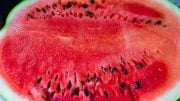

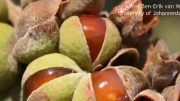

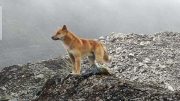
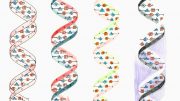


Be the first to comment on "Improving Watermelons by Harvesting Genes From Wild Species"